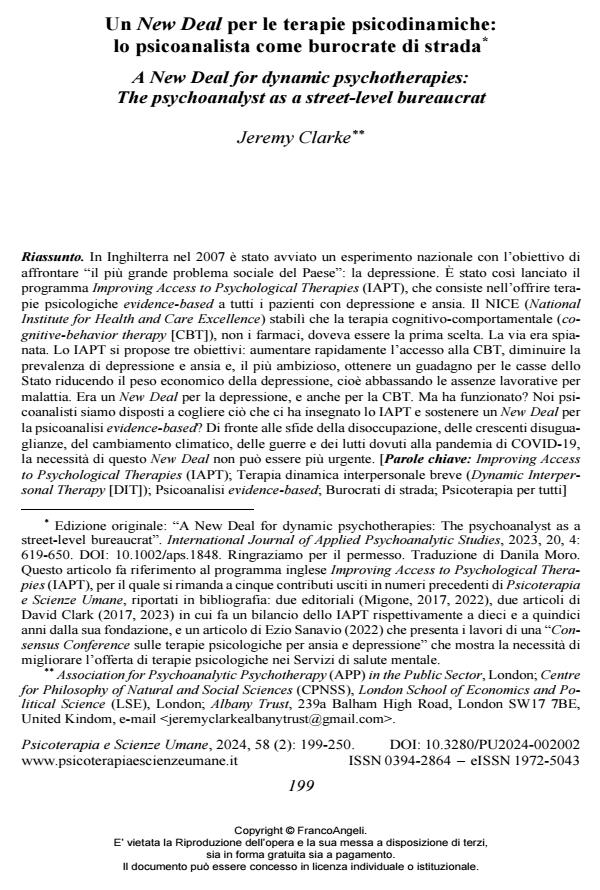Un New Deal per le terapie psicodinamiche: lo psicoanalista come burocrate di strada
Titolo Rivista PSICOTERAPIA E SCIENZE UMANE
Autori/Curatori Jeremy Clarke
Anno di pubblicazione 2024 Fascicolo 2024/2
Lingua Italiano Numero pagine 52 P. 199-250 Dimensione file 632 KB
DOI 10.3280/PU2024-002002
Il DOI è il codice a barre della proprietà intellettuale: per saperne di più
clicca qui
Qui sotto puoi vedere in anteprima la prima pagina di questo articolo.
Se questo articolo ti interessa, lo puoi acquistare (e scaricare in formato pdf) seguendo le facili indicazioni per acquistare il download credit. Acquista Download Credits per scaricare questo Articolo in formato PDF

FrancoAngeli è membro della Publishers International Linking Association, Inc (PILA)associazione indipendente e non profit per facilitare (attraverso i servizi tecnologici implementati da CrossRef.org) l’accesso degli studiosi ai contenuti digitali nelle pubblicazioni professionali e scientifiche
In Inghilterra nel 2007 è stato avviato un esperimento nazionale con l’obiettivo di affrontare “il più grande problema sociale del Paese”: la depressione. È stato così lanciato il programma Impro-ving Access to Psychological Therapies (IAPT), che consiste nell’offrire terapie psicologiche evidence-based a tutti i pazienti con depressione e ansia. Il NICE (National Institute for Health and Care Excellence) stabilì che la terapia cognitivo-comportamentale (cognitive-behavior therapy [CBT]), non i farmaci, doveva essere la prima scelta. La via era spianata. Lo IAPT si propose tre obiettivi: aumentare rapidamente l’accesso alla CBT, diminuire la prevalenza di depressione e an-sia e, il più ambizioso, ottenere un guadagno per le casse dello Stato riducendo il peso economico della depressione, cioè abbassando le assenze lavorative per malattia. Era un New Deal per la depressione, e anche per la CBT. Ma ha funzionato? Noi psicoanalisti siamo disposti a cogliere ciò che ci ha insegnato lo IAPT e sostenere un New Deal per la psicoanalisi evidence-based? Di fron-te alle sfide della disoccupazione, delle crescenti disuguaglianze, del cambiamento climatico, delle guerre e dei lutti dovuti alla pandemia di COVID-19, la necessità di questo New Deal non può essere più urgente.
Parole chiave:Improving Access to Psychological Therapies (IAPT); Terapia dinamica interpersonale breve (Dynamic Interpersonal Therapy [DIT]); Psicoanalisi eviden-ce-based; Burocrati da strada; Psicoterapia per tutti
- Le Opere Complete di Paul Parin in 19 volumi Marco Conci, in PSICOTERAPIA E SCIENZE UMANE 2/2024 pp.303
DOI: 10.3280/PU2024-002007 - Risposta agli interventi di Mauro Fornaro e Piero Porcelli Francesco Bottaccioli, Anna Giulia Bottaccioli, in PSICOTERAPIA E SCIENZE UMANE 2/2024 pp.297
DOI: 10.3280/PU2024-002006 - Commento sull'articolo di F. Bottaccioli & A.G. Bottaccioli "Franz Alexander, uno scienziato contemporaneo: un nuovo paradigma per la psicologia e la medicina" Piero Porcelli, in PSICOTERAPIA E SCIENZE UMANE 2/2024 pp.290
DOI: 10.3280/PU2024-002005 - Psicosomatica: un caso di araba fenice. Note a latere dell'articolo di F. Bottaccioli & A.G. Bottaccioli "Franz Alexander, uno scienziato contemporaneo: un nuovo paradigma per la psicologia e la medicina" Mauro Fornaro, in PSICOTERAPIA E SCIENZE UMANE 2/2024 pp.281
DOI: 10.3280/PU2024-002004
Jeremy Clarke, Un New Deal per le terapie psicodinamiche: lo psicoanalista come burocrate di strada in "PSICOTERAPIA E SCIENZE UMANE" 2/2024, pp 199-250, DOI: 10.3280/PU2024-002002